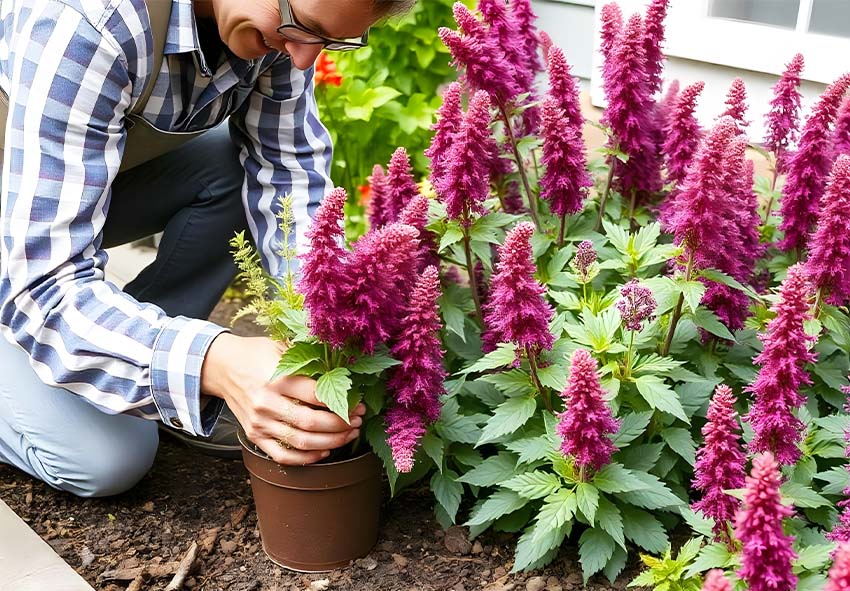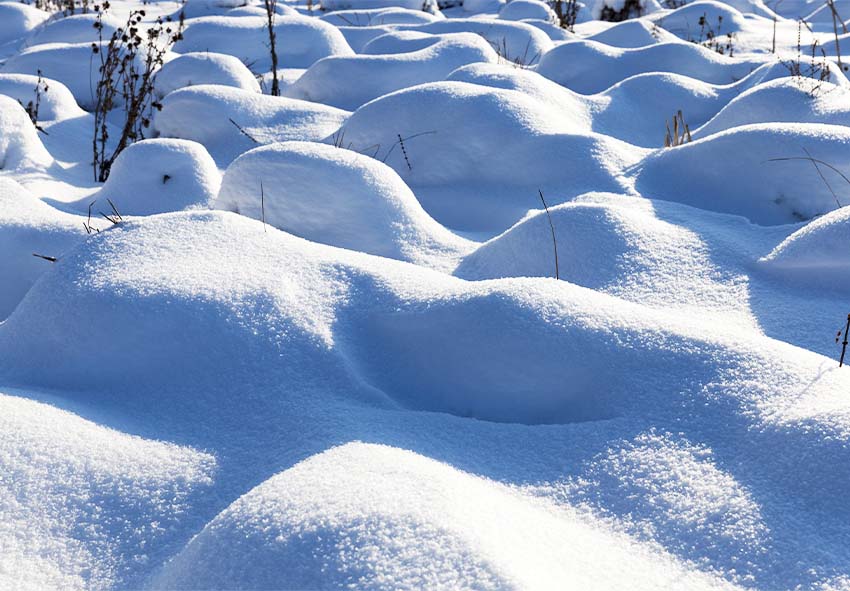Astilbe is a popular perennial plant known for its vibrant, feathery blooms and its ability to thrive in shady garden areas. Proper seasonal care is essential to ensure healthy growth and stunning floral displays throughout the year. In this guide, we will cover how to care for Astilbe in spring, summer, fall, and winter, ensuring that your plants remain robust and vibrant across all seasons. Our gardening blog is a perfect place to find any information you need.
Spring Care for Astilbe
Spring marks the start of new growth for Astilbe, making it a crucial time to prepare your garden for the upcoming season. With the right care, you can set your plants up for lush foliage and vibrant blooms. From soil preparation to early watering, here’s how to support your Astilbe in spring.
Preparing the Soil for New Growth
In early spring, it’s important to prepare the soil to support new Astilbe growth. Begin by loosening the soil around the plants and adding organic matter such as compost or well-rotted manure. This will improve drainage and boost nutrient levels, which is crucial for healthy roots. Check for any damage from winter frost and remove debris to promote healthy growth.
Watering and Fertilizing in Spring
As temperatures rise, Astilbe requires consistent moisture to thrive. Here are some mai tips for watering and fertilizing your plants:
- Start watering early: As temperatures rise, water Astilbe regularly to keep the soil consistently moist but not waterlogged.
- Deep watering: Ensure water reaches deep into the root zone, especially after dry winter months.
- Fertilize after new growth appears: Apply a balanced, slow-release fertilizer once new shoots emerge to encourage robust growth.
- Use organic compost: Incorporating compost into the soil will provide essential nutrients and improve soil structure.
- Monitor moisture levels: Check the soil frequently, particularly during dry spells, to maintain consistent moisture for optimal growth.
Summer Care for Astilbe

As temperatures rise, Astilbe needs extra attention to thrive through the hotter months. Summer care focuses on consistent watering, pruning, and managing pests to keep your plants healthy and blooming. Follow these tips to ensure your Astilbe stays lush and beautiful all season long.
Managing Watering Needs in Hot Weather
Astilbe thrives in moist, well-drained soil, making summer watering critical, especially in hot, dry periods. Ensure the soil remains damp, and consider using mulch to retain moisture and regulate the soil temperature. Mulching helps prevent the roots from overheating while keeping the soil hydrated for longer periods.
Deadheading and Pruning
To keep your Astilbe looking fresh and to encourage continuous blooming, deadheading is key. Remove spent flowers to allow the plant to direct its energy towards producing new blooms rather than seed production. Prune back any dead or damaged foliage during the summer months to maintain the plant’s appearance and prevent disease spread.
Pest and Disease Control
During the summer, Astilbe can be susceptible to pests such as aphids and diseases like powdery mildew. That’s why they may need a special care during this period:
- Inspect for early pests: Regularly check for common spring pests like aphids, slugs, and snails that can damage new growth.
- Use natural repellents: Introduce natural predators such as ladybugs or apply organic insecticidal soap to keep pests under control.
- Monitor for fungal diseases: Keep an eye out for powdery mildew and leaf spots, which can affect Astilbe in moist conditions.
- Improve air circulation: Space plants properly and prune surrounding foliage to enhance airflow, reducing the risk of fungal infections.
- Avoid overwatering: Excess moisture can lead to root rot; ensure well-drained soil and water appropriately to prevent disease.
Fall Care for Astilbe

Fall is a time to help your Astilbe transition into winter dormancy while preparing it for next year’s growth. This season is perfect for dividing and transplanting, as well as making sure your plants are ready for colder temperatures. Proper fall care ensures a strong comeback next spring.
Preparing Astilbe for Winter
As fall approaches, it’s time to help your Astilbe prepare for winter dormancy. Cut back the stems to a few inches above the ground after the plant has finished blooming. Apply a thick layer of mulch around the base of the plants to insulate the roots and protect them from freezing temperatures. Amending the soil with compost can also improve the soil’s nutrient content in preparation for the next growing season. Find more important information in our full guide for Astilbe.
Dividing and Transplanting
Fall is an ideal time to divide and transplant overgrown Astilbe clumps:
- Choose the right time: Divide Astilbe in early to mid-fall, after the plant has finished blooming but before the first frost.
- Prepare the tools: Use a sharp spade or garden fork to gently lift the clump out of the ground without damaging roots.
- Separate the clumps: Divide the plant into smaller sections, ensuring each has healthy roots and 2-3 shoots.
- Prepare new planting holes: Dig holes in well-drained soil, spacing the divisions about 18-24 inches apart.
- Replant and water: Place the divisions in their new locations, cover the roots with soil, and water thoroughly to help them settle.
- Mulch for protection: Add a layer of mulch around the newly transplanted Astilbe to retain moisture and protect against the cold.
Winter Care for Astilbe

Winter brings challenges such as frost and freezing, but with proper care, your Astilbe can survive and thrive. Protecting the plants from harsh conditions and monitoring them throughout the colder months will set the stage for a healthy revival in the spring. Here’s how to care for Astilbe during winter.
Protecting Astilbe from Frost and Cold
Astilbe can tolerate cold weather, but harsh winters may require additional protection. Covering the plant base with a thick layer of mulch will shield the roots from freezing temperatures. In regions with severe winters, adding a frost cloth or straw can provide extra insulation and prevent frost damage.
Monitoring for Winter Damage
Throughout winter, periodically inspect your Astilbe for any kind of damages or signs of diseases:
- Inspect for frost damage: Check Astilbe plants for signs of frostbite on leaves and stems after winter storms.
- Look for root exposure: Ensure the roots haven’t been pushed out of the soil due to freezing and thawing cycles.
- Check for soggy soil: Examine the ground for excessive moisture, which can cause root rot in winter.
- Assess mulch condition: Make sure the mulch layer remains intact and thick enough to protect against cold and fluctuating temperatures.
- Watch for broken stems: Prune any damaged or broken stems to prevent disease or pests as the weather warms.
Conclusion
Caring for Astilbe throughout the year requires attention to each season’s unique challenges and opportunities. By preparing the soil in spring, maintaining proper moisture in summer, cutting back and dividing in fall, and protecting the plants during winter, you’ll ensure your Astilbe flourishes year after year. For more resources or to shop for Astilbe varieties, visit our online plant store and explore the beauty these versatile perennials can bring to your garden.
Frequently Asked Questions (FAQs) about Seasonal Care for Astilbe
1. When should I divide my Astilbe plants?
The best time to divide Astilbe is in the fall, after the blooming season has ended. Dividing in fall allows the plants to establish new roots before winter dormancy. Be sure to divide healthy, mature clumps every 3 to 5 years to maintain their vigor and prevent overcrowding.
2. How much water does Astilbe need in summer?
Astilbe prefers consistently moist soil, especially during the hot summer months. Water deeply 2-3 times a week, depending on the heat and dryness. Mulching can help retain moisture and keep the soil cool, ensuring that your Astilbe doesn’t suffer from drought stress.
3. How do I prepare Astilbe for winter?
In fall, cut back the spent foliage to just above ground level and add a thick layer of mulch to protect the roots from freezing temperatures. Mulching insulates the soil and helps prevent frost heave, where the roots are pushed out due to freeze-thaw cycles.
4. What are common pests and diseases affecting Astilbe?
Common pests that attack Astilbe include aphids, slugs, and spider mites. Diseases such as powdery mildew and root rot can also occur, especially in poorly drained soil. Regular inspection, proper watering practices, and using natural pest repellents can help prevent these issues.
5. Can I order Holland Astilbe from your online store?
Yes, you can! Our online store Dutch-bulbs.com offers a wide selection of Astilbe plants, including different varieties and colors. We take pride in providing top-quality plants that are carefully cultivated and shipped with care to ensure they reach you in perfect condition.
Published: 23.09.2024

